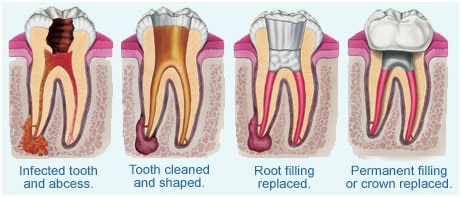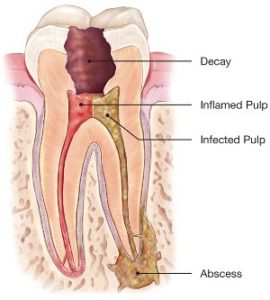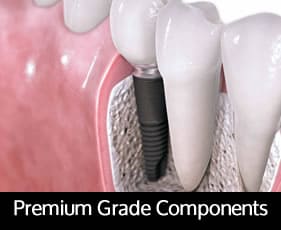Root Canal Treatment in Leeds – Book Now
What is a Root Canal?
A root canal is a treatment used to repair and save a tooth that is badly decayed or becomes infected. During the procedure, the nerve and pulp are removed and the inside of the tooth is cleaned and sealed. Without root canal treatment, the tissue surrounding the tooth will become infected and abscesses may form, increasing the likelihood of losing the tooth altogether.

“Root canal” is the term used to describe the natural space/ cavity within the centre of the tooth. The pulp or pulp chamber is the soft area within this space. The tooth’s nerve also lies within the root canal.
Recommended Related to Oral Health
Your mouth is more than just a pretty smile. It’s also a gateway to your overall health. Keeping that gateway clean may keep you healthier longer — and looking younger. Just as white, straight teeth convey youth, a smile with crooked, discoloured, worn, or missing teeth is associated with an aged look.
A tooth’s nerve is not vitally important to a tooth’s health and function after the tooth has emerged through the gums. Its only function is sensory — to provide the sensation of hot or cold. The presence or absence of a nerve will not affect the day-to-day functioning of the tooth.
Damage to the Pulp
When a tooth’s nerve tissue or pulp is damaged, it breaks down and bacteria begin to multiply within the pulp chamber. The bacteria and other decayed debris can cause an infection or abscessed tooth. An abscess is a pus-filled pocket that forms at the end of the roots of the tooth. An abscess occurs when the infection spreads all the way past the ends of the roots of the tooth. This can cause raging toothache. In addition to an abscess, an infection in the root canal of a tooth can cause:
- Swelling that may spread to other areas of the face, neck, or head. This can be life threatening in some situations.
- Bone loss around the tip of the root
- Drainage problems extending outward from the root. A hole can occur through the side of the tooth with drainage into the gums or through the cheek with drainage through the skin.
Root canal treatments are complex, technically demanding procedures. They involve negotiating the root canal of the offending tooth using very fine specialised instruments. The canal system is cleaned mechanically and chemically. The canal is then filled and sealed with a special rubber called Gutta Percha. A filling or restoration may be placed over the Gutta Percha to provide a further seal.
A tooth that has had a root canal often is one that has a large filling or extensive decay or other weakness, a crown, crown and post, or other restoration often needs to be placed on the tooth to protect it, prevent it from breaking, and restore it to full function. This will be discussed prior to embarking on the root treatment. We have invested in the latest equipment, including rotary endodontic motors to provide successful root canal treatments as effectively as possible.






